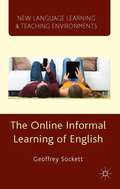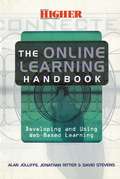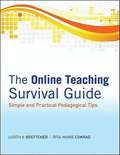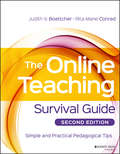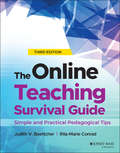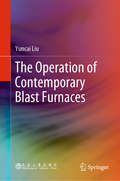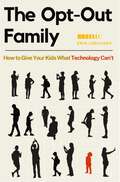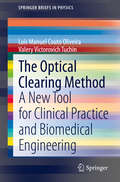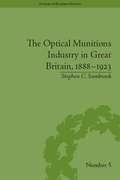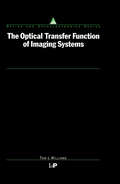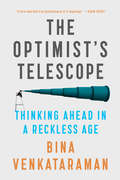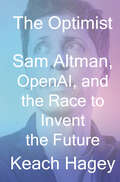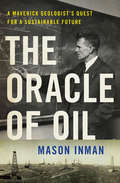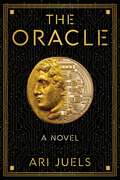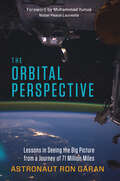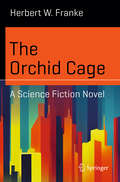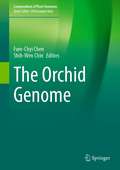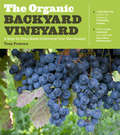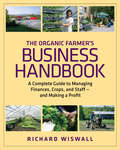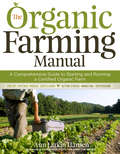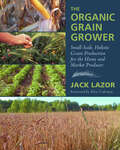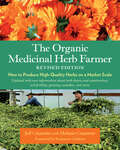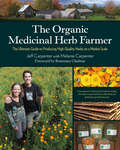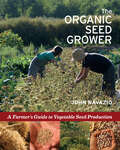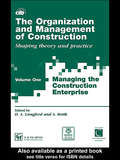- Table View
- List View
The Online Informal Learning of English
by Geoffrey SockettYoung people around the world are increasingly able to access English language media online for leisure purposes and interact with other users of English. This book examines the extent of these phenomena, their effect on language acquisition and their implications for the teaching of English in the 21st century.
The Online Learning Handbook: Developing and Using Web-based Learning
by David Stevens Alan Jolliffe Jonathan RitterA guide to developing Web-based learning materials. It provides advice, tools and techniques to help readers harness the potential of on-line methods of instruction and education. Taking a simple step-by-step approach, it proceeds from the basics through to operating computer-managed learning.
The Online Teaching Survival Guide
by Rita-Marie Conrad Judith V. BoettcherThe Online Teaching Survival Guide provides an overview of theory-based techniques for online teaching or for a technology-enhanced course, including course management, social presence, community building, and debriefing. Based on traditional pedagogical theory, this resource integrates the latest research in cognitive processing and learning outcomes. From a practical approach, this guidebook presents instructional strategies in a four-phase timeline, suitable for any online or blended course. Faculty with little knowledge of educational theory and those well-versed in pedagogy will find this book a key to developing their practical online teaching skills.
The Online Teaching Survival Guide: Simple and Practical Pedagogical Tips
by Rita-Marie Conrad Judith V. BoettcherEssential reading for online instructors, updated to cover new and emerging issues and technologies The Online Teaching Survival Guide provides a robust overview of theory-based techniques for teaching online or technology-enhanced courses. Covering all aspects of online teaching, this book reviews the latest research in cognitive processing and related learning outcomes while retaining a focus on the practical. A simple framework of instructional strategies mapped across a four-phase timeline provides a concrete starting point for both new online teachers and experienced teachers designing or revamping an online course. Essential technologies are explored in their basic and expanded forms, and traditional pedagogy serves as the foundation for tips and practices customized for online learning. The tips cover course management, social presence, community building, integration of new technologies, discussion and questioning techniques, assessment, and debriefing, along with new coverage of intensive or accelerated courses, customizing learning strategies, developing expertise, advanced course design, and assessment techniques exclusive to this new second edition. The theory and techniques of successful online teaching can be significantly different from those used face-to-face. With more and more classes being offered online, this book provides a valuable resource for taking your course to the next level. Understand the technology used in online teaching Learn specialized pedagogical tips and practices Examine new research on cognition and learning Adopt a clear framework of instructional strategies The explosion of online learning has created a demand for great online teachers. Increasingly, faculty who normally teach face-to-face are being asked to cover online courses—yet comprehensive pedagogical resources are scarce. The learning curve is huge, and faculty need a practical approach to course design and management that can be quickly and easily implemented. The Online Teaching Survival Guide provides that essential resource, with a customizable framework and deeper exploration of effective online teaching.
The Online Teaching Survival Guide: Simple and Practical Pedagogical Tips
by Rita-Marie Conrad Judith V. BoettcherA timely update to the best-selling, practical, and comprehensive guide to online teaching The Online Teaching Survival Guide provides a robust overview of theory-based techniques for teaching online or technology-enhanced courses. This Third Edition is a practical resource for educators learning to navigate the online teaching sector. It presents a framework of simple, research-grounded instructional strategies that work for any online or blended course. This new edition is enhanced with hints on integrating problem-solving strategies, assessment strategies, student independence, collaboration, synchronous strategies, and building metacognitive skills. This book also reviews the latest research in cognitive processing and related learning outcomes. New and experienced online teachers alike will appreciate this book’s exploration of essential technologies, course management techniques, social presence, community building, discussion and questioning techniques, assessment, debriefing, and more. With more and more classes being offered online, this book provides a valuable resource for taking your course to the next level. Understand the technology used in online teaching and discover how you can make the most of advanced features in the tech you use Learn specialized pedagogical tips and practices that will make the shift to online teaching smoother for you and your students Examine new research on cognition and learning, and see how you can apply these research findings your day-to-day Adopt a clear framework of instructional strategies that will work in any online or blended setting Learn how to make the most of your synchronous online class meetings using flipped model techniques integrated with asynchronous conversation Recently, schools across the globe have experienced a shift to online courses and teaching. The theories and techniques of synchronous virtual online teaching are vastly different from traditional educational pedagogy. You can overcome the learning curve with this theory-based, hands-on guide.
The Operation of Contemporary Blast Furnaces
by Yuncai LiuThis book focuses on how to keep blast furnaces running stably and smoothly with low consumption and long operating life spans. Assessing and adjusting blast furnace performance are key to operation. The book describes in detail cases of both successful and failed blast furnace operation. It also demonstrates various phenomena and “symptoms” in the smelting process that have rarely been studied before, e.g. abnormal gas distribution, bending loss of tuyere, slag crust fall-off, blast furnace thickening, and hearth accumulation. As such, it will help readers understand internal phenomena in blast furnaces, providing a basis for developing intelligent control and management systems.
The Opt-Out Family: How to Give Your Kids What Technology Can't
by Erin LoechnerDiscover a new and hopeful path forward as you consider your family's approach to social media, screen time, and technology.We've all heard the mind-boggling statistics about technology and social media use. The numbers don't lie; our obsession with smartphones and social media is slowly eroding the very essence of our homes and families. We see it. We feel it. We know it.So what do we do about it?Spoiler alert: Forget parental control apps, time limits, or reward charts. This revolutionary path takes us into the heart of the beast itself: the social media algorithm. Former social media influencer and trailblazer Erin Loechner has seen the perks and pitfalls of social media usage, and she knows how to hack the strategies of tech wizards and platform experts so you can borrow their billion-dollar playbook to engage your family in meaningful ways away from screens.The Opt-Out Family is packed with eye-opening research and startling insights, as well as practical encouragement and creative ideas to transform your family's relationship with today's ever-evolving technology. As a result, you will:Experience more quality time with your children that doesn't revolve around screensCreate healthy habits as a family that will set your children up for success in the futureDiscover what your kids actually need from you, and learn how to delight and engage them better than a device canAnd, ultimately, establish true and lasting influence within your own four walls--and far beyondThe Opt-Out Family unlocks a world where genuine connections flourish and technology takes a backseat. It's time to reclaim your home and build a tech-free family culture that's stronger than your Wi-Fi signal.
The Optical Clearing Method: A New Tool for Clinical Practice and Biomedical Engineering (SpringerBriefs in Physics)
by Luís Manuel Oliveira Valery Victorovich TuchinThis book describes the Optical Immersion Clearing method and its application to acquire information with importance for clinical practice and various fields of biomedical engineering. The method has proved to be a reliable means of increasing tissue transparency, allowing the investigator or surgeon to reach deeper tissue layers for improved imaging and laser surgery. This result is obtained by partial replacement of tissue water with an active optical clearing agent (OCA) that has a higher refractive index and is a better match for the refractive index of other tissue components. Natural tissue scattering is thereby reduced. An exponential increase in research using this method has occurred in recent years, and new applications have emerged, both in clinical practice and in some areas of biomedical engineering. Recent research has revealed that treating ex vivo tissues with solutions containing active OCAs in different concentrations produces experimental data to characterize drug delivery or to discriminate between normal and pathological tissues. The obtained drug diffusion properties are of interest for the pharmaceutical and organ preservation industry. Similar data can be estimated with particular interest for food preservation. The free water content evaluation is also of great interest since it facilitates the characterization of tissues to discriminate pathologies. An interesting new application that is presented in the book regards the creation of two optical windows in the ultraviolet spectral range through the application of the immersion method. These induced transparency windows open the possibility to diagnose and treat pathologies with ultraviolet light. This book presents photographs from the tissues we have studied and figures that represent the experimental setups used. Graphs and tables are also included to show the numerical results obtained in the sequential calculations performed.
The Optical Munitions Industry in Great Britain, 1888–1923 (Studies in Business History #5)
by Stephen C SambrookRunning counter to the general decline of technological industries in post-Victorian Britain, optical munitions provides an important, previously overlooked, study into the business of manufacturing.
The Optical Transfer Function of Imaging Systems (Series In Optics And Optoelectronics Ser.)
by Thomas WilliamsThe Optical Transfer Function of Imaging Systems deals extensively with the theoretical concept of the optical transfer function (OTF), its measurement, and application to imaging devices. The OTF is a mathematical entity describing how well the subject is transferred into an image via the lens.The book focuses on the practical aspects of using and measuring the OTF. It presents the background physics necessary to understand and assess the performance of the great proliferation of electro-optical systems, including image intensifiers, video cameras, and thermal imagers. Assuming a senior undergraduate level of optics knowledge, the book is suitable for graduate courses in optics, electro-optics, and photographic science. In addition, it is a practical guide for systems designers who require a means of assessing and specifying the performance of imaging systems. It is also of interest to physicists and engineers working in all areas of imaging.
The Optimist's Telescope: Thinking Ahead in a Reckless Age
by Bina VenkataramanA trailblazing exploration of how we can plan better for the future: our own, our families’, and our society’s. Instant gratification is the norm today—in our lives, our culture, our economy, and our politics. Many of us have forgotten (if we ever learned) how to make smart decisions for the long run. Whether it comes to our finances, our health, our communities, or our planet, it’s easy to avoid thinking ahead.The consequences of this immediacy are stark: Superbugs spawned by the overuse of antibiotics endanger our health. Companies that fail to invest stagnate and fall behind. Hurricanes and wildfires turn deadly for communities that could have taken more precaution. Today more than ever, all of us need to know how we can make better long-term decisions in our lives, businesses, and society. Bina Venkataraman sees the way forward. A former journalist and adviser in the Obama administration, she helped communities and businesses prepare for climate change, and she learned firsthand why people don’t think ahead—and what can be done to change that. In The Optimist’s Telescope, she draws from stories she has reported around the world and new research in biology, psychology, and economics to explain how we can make decisions that benefit us over time. With examples from ancient Pompeii to modern-day Fukushima, she dispels the myth that human nature is impossibly reckless and highlights the surprising practices each of us can adopt in our own lives—and the ones we must fight for as a society. The result is a book brimming with the ideas and insights all of us need in order to forge a better future.
The Optimist: Sam Altman, OpenAI, and the Race to Invent the Future
by Keach Hagey“The first major biography of tech’s newest titan, this sets a high bar for those to follow.”—Publishers Weekly, starred review “An exemplary blend of biography, financial technology reportage, and futurology.”—Kirkus, starred review From an acclaimed Wall Street Journal reporter comes the first biography of the enigmatic leader of the AI revolution, charting his ascent within the tech world as well as his ambitions for this powerful new technology. On November 30, 2022, OpenAI released ChatGPT, a chatbot that captivated the world with its uncanny ability to hold humanlike conversations. Not even a year later, on November 17, 2023, Sam Altman, the CEO of OpenAI, was summarily fired on a video call by the company’s board. The firing made headlines around the globe: OpenAI is the leader in the race to build AGI—artificial general intelligence, or AI that can think like a human being—and Altman is the most prominent figure in the field. Yet it was mere days before Altman was back running the company he had co-founded, with most of the directors who voted to fire him themselves removed from the board. The episode was a demonstration of how quickly the industry is moving, and of Altman’s power to bend reality to his will. In The Optimist, the Wall Street Journal reporter Keach Hagey presents the most detailed account yet of Altman’s rise, from his precocious childhood in St. Louis to his first, failed startup experience; his time as legendary entrepreneur Paul Graham’s protégé and successor as head of Y Combinator, the start-up accelerator where Altman became the premier power broker in Silicon Valley; the founding of OpenAI and his recruitment of a small yet superior team; and his struggle to keep his company at the cutting edge while fending off determined rivals, including Elon Musk, a former friend and now Altman’s bitter opponent. Hagey conducted more than 250 interviews, with Altman’s family, friends, teachers, mentors, co-founders, colleagues, investors, and portfolio companies, in addition to spending hours with Altman himself. The person who emerges in her portrait is a brilliant dealmaker with a love of risk, who believes in technological progress with an almost religious conviction—yet who sometimes moves too fast for the people around him. With both the promise and peril of AI increasing by the day, Hagey delivers a nuanced, balanced, revelatory account of the individual who is leading us into what he himself has called “the intelligence age.” Altman is a figure out of Isaac Asimov or Neal Stephenson. Or he is the author himself: if it feels as though we have all collectively stepped into a science fiction short story, it is Altman who is writing it.
The Oracle of Oil: A Maverick Geologist's Quest for a Sustainable Future
by Mason InmanThe first comprehensive biography of Marion King Hubbert, the "father of peak oil." In 1956, geologist and Shell Oil researcher Marion King Hubbert delivered a speech that has shaped world energy debates ever since. Addressing the American Petroleum Institute, Hubbert dropped a bombshell on his audience: U.S. oil production would peak by 1970 and decline steadily thereafter. World production would follow the same fate, reaching its peak soon after the turn of the millennium. In battles stretching over decades, Hubbert defended his forecasts against opponents from both the oil industry and government. Hubbert was proved largely correct during the energy crises of the 1970s and hailed as a "prophet" and an "oracle." Even amid our twenty-first-century fracking boom, Hubbert's underlying logic holds true--while remaining a source of debate and controversy. A rich biography of the man behind peak oil, The Oracle of Oil follows Hubbert from his early days as a University of Chicago undergraduate to his first, ill-fated forays into politics in the midcentury Technocracy movement, and charts his rise as a top geologist in the oil industry and energy expert within the U.S. government. In a deeply researched narrative that mines Hubbert's papers and correspondence for the first time, award-winning journalist Mason Inman rescues the story of a man who shocked the scientific community with his eccentric brilliance. The Oracle of Oil also skillfully situates Hubbert in his era: a time of great intellectual ferment and discovery, tinged by dark undercurrents of intellectual witch hunts. Hubbert emerges as an unapologetic iconoclast who championed sustainability through his lifelong quest to wean the United States--and the wider world--off fossil fuels, as well as by questioning the pursuit of never-ending growth. In its portrait of a man whose prescient ideas still resonate today, The Oracle of Oil looks to the past to find a guiding philosophy for our future.
The Oracle: A Novel
by Ari JuelsFears of a weaponized blockchain become reality when a software developer races to deactivate the rogue smart contract targeting him for assassination. Life is comfortable for a prominent, if schlubby, developer at a New York City blockchain company. That is, until FBI Special Agent Diane Duménil seeks his help against a bewildering threat: The Delphians, worshippers of the god Apollo, have launched a rogue program on a blockchain. It&’s offering a crypto bounty to assassinate a European archaeology professor. The developer brushes off the danger until he learns the next target: Himself. Mythical antiquity collides with a near-future cyberworld as The Oracle&’s unassuming hero and his FBI partner race against time to dismantle the Delphians&’ murderous blockchain software. Theirs is a whirlwind tale of oracles ancient and modern, vanished antiquities and conjured crypto billions, cybercriminals and digital idealists—narrated by a cynical hero normally more concerned with dark chocolate than the consequences of the technologies he&’s pioneering. What happens when the crypto ideals of privacy and truth might cost human lives—especially your own?
The Orbital Perspective: Lessons in Seeing the Big Picture from a Journey of 71 Million Miles
by Ron GaranFor astronaut Ron Garan, living on the International Space Station was a powerful, transformative experience—one that he believes holds the key to solving our problems here on Earth. On space walks and through windows, Garan was struck by the stunning beauty of the Earth from space but sobered by knowing how much needed to be done to help this troubled planet. And yet on the International Space Station, Garan, a former fighter pilot, was working work side by side with Russians, who only a few years before were “the enemy.” If fifteen nationalities could collaborate on one of the most ambitious, technologically complicated undertakings in history, surely we can apply that kind of cooperation and innovation toward creating a better world. That spirit is what Garan calls the “orbital perspective.”Garan vividly conveys what it was like learning to work with a diverse group of people in an environment only a handful of human beings have ever known. But more importantly, he describes how he and others are working to apply the orbital perspective here at home, embracing new partnerships and processes to promote peace and combat hunger, thirst, poverty, and environmental destruction. This book is a call to action for each of us to care for the most important space station of all: planet Earth. You don't need to be an astronaut to have the orbital perspective. Garan's message of elevated empathy is an inspiration to all who seek a better world.
The Orchid Cage: A Science Fiction Novel (Science and Fiction)
by Herbert W. FrankeThis book is a new English translation of the classic science fiction story written in 1961 by Herbert W. Franke, widely held to be the most important German-language science-fiction writer. A dead city on a distant planet, two groups of people trying to explore it. Step by step, they penetrate the outer ring with its ultra-modern technology, the half-ruined medieval city center and finally the mysterious center. But is the eerie city really dead? Suddenly the factories start working again, the automatons intervene, and somewhere in the background there is still something hidden that could perhaps awaken. But is it people or machines? Herbert W. Franke leads the reader into an oppressively strange world; only after the startling resolution does it become clear what lies behind the adventures of the intruders - not a cosmic strangeness, but a threatening development that could affect humans in the same way. Franke's novel is thus a parable of the evolution of all humans in the age of technical communication ...
The Orchid Genome (Compendium of Plant Genomes)
by Fure-Chyi Chen Shih-Wen ChinThis book provides information on genome complexity and evolution, transcriptome analysis, miRNome, simple sequence repeats, genome relationships, molecular cytogenetics, polyploidy induction and application, flower and embryo development. Orchids account for a great part of the worldwide floriculture trade both as cut flowers and as potted plants and are assessed to comprise around 10% of global fresh cut flower trade. A better understanding of the basic botanical characteristics, flower regulation, molecular cytogenetics, karyotypes and DNA content of important orchids will aid in the efficient development of new cultivars. The book also describes the composition, expression and function of various microRNAs and simple sequence repeats. Information on their involvement in all aspects of plant growth and development will aid functional genomics studies.
The Organic Backyard Vineyard: A Step-by-Step Guide to Growing Your Own Grapes
by Tom PowersInterest in wine shows no signs of slowing down—wine tours, tastings, and vacations are now common and homeowners often have space dedicated to their collection. The logical next step? Learning to grow and make your own.In The Organic Backyard Vineyard expert Tom Powers walks the small grower through the entire process of growing grapes, with a month-by-month maintenance guide covering all regions of the U.S. and Canada. He explains everything a beginning grape grower needs to know: how to design and build a vineyard, how to select grapes for each region, how to maximize yield using organic maintenance techniques, how to build a trellis, how to harvest at peak flavor, and how to store grapes for winemaking.This edition includes organic growing information and all new photography.
The Organic Farmer's Business Handbook: A Complete Guide to Managing Finances, Crops, and Staff - and Making a Profit
by Richard WiswallContrary to popular belief, a good living can be made on an organic farm. What&’s required is farming smarter, not harder.In The Organic Farmer&’s Business Handbook, Richard Wiswall shares advice on how to make your vegetable production more efficient, better manage your employees and finances, and turn a profit. From his twenty-seven years of experience at Cate Farm in Vermont, Wiswall knows firsthand the joys of starting and operating an organic farm—as well as the challenges of making a living from one. Farming offers fundamental satisfaction from producing food, working outdoors, being one&’s own boss, and working intimately with nature. But, unfortunately, many farmers avoid learning about the business end of farming; because of this, they often work harder than they need to, or quit farming altogether because of frustrating—and often avoidable—losses.In this comprehensive business kit, Wiswall covers:Step-by-step procedures to make your crop production more efficientAdvice on managing employees, farm operations, and office systemsNovel marketing strategiesWhat to do with your profits: business spending, investing, and planning for retirementA companion toolkit, available for download upon purchase of the book, offers valuable business tools, including easy-to-use spreadsheets for projecting cash flow, a payroll calculator, comprehensive crop budgets for forty different crops, and tax planners.
The Organic Farming Manual: A Comprehensive Guide to Starting and Running a Certified Organic Farm
by Ann Larkin HansenProviding expert tips on tending the land, caring for animals, and necessary equipment, Ann Larkin Hansen also covers the intricate process of acquiring organic certification and other business considerations important to a profitable operation. Discover the rewarding satisfaction of running a successful and sustainable organic farm.
The Organic Grain Grower: Small-Scale, Holistic Grain Production for the Home and Market Producer
by Jack Lazor&“The Organic Grain Grower is the best resource we&’ve seen for small-scale grain growers everywhere. . . . [Lazor&’s] passion comes alive in this fine guidebook&’s depth of detail.&”—Mother Earth NewsThe ultimate guide to growing organic grains on a small and ecological scale The Organic Grain Grower is invaluable for both home-scale and commercial producers interested in expanding their resiliency and crop diversity through growing their own grains. Longtime farmer and organic pioneer Jack Lazor covers how to grow and store wheat, barley, oats, corn, dry beans, soybeans, pulse crops, oilseeds, grasses, nutrient-dense forages, and lesser-known cereals. In addition to detailed cultivation and processing information, Lazor argues the importance of integrating grains on the organic farm (not to mention for the local-food system) for reasons of biodiversity and whole farm management. Including extensive information on:The history of grain growing and consumption in North AmericaThe twenty-first century and the birth of the local-food movementConsidering your farm&’s scale and climateUnderstanding soil fertility and structurePlanting your crop (including spring vs. fall cereals and preparing your soil)The growing and ripening process (reproductive, milk, hard-and-soft dough stages)The grain harvestPreparing grain for sale, storage, or end use (drying, cleaning seed, grain handling)Seed breeding and savingMachinery, infrastructure, and processing (both home-scale tools and larger farm equipment)Grinding grains for livestock rations (including how to put together a ration based on protein content) and sample rations for dairy cows, pigs, and chickensProcessing grains for human consumptionAdditional resources and information for new grain farmers, and more…Beginners will learn how to grow enough wheat for a year&’s supply of bread flour for their homestead, and farmers will learn how to become part of a grain co-op, working alongside artisan bakers and mills. Never before has there been a guide to growing organic grains applicable both for the home-scale and professional farming scale.This will be a classic for decades to come and a crucial addition to any farmer&’s, homesteader&’s, gardener&’s, agronomist&’s, or seed-saver&’s library.
The Organic Medicinal Herb Farmer, Revised Edition: How to Produce High-Quality Herbs on a Market Scale
by Jeff Carpenter&“Seasoned and novice growers alike will find a mother lode of information and wisdom packed into this gem of a book!&”—Nancy Phillips, author of The Herbalist&’s Way*Updated with new information about herb dryers and construction, soil fertility, growing cannabis, and moreIn the first edition of The Organic Medicinal Herb Farmer, authors Jeff and Melanie Carpenter presented a comprehensive seed-to-bottle guide for aspiring and experienced growers alike, from basic business considerations to planting and propagation to creating value-added products. Now they&’re back with a revised and updated edition, sharing the lessons they&’ve learned throughout their twenty-five years of operating a medicinal herb farm that prizes quality over quantity.The Carpenters offer their insights and tips on every aspect of herb farming, including:Size and scale considerationsData management for profit maximizationThe herbal marketplace and choosing which herbs to growField and bed preparation and planting, including building soil fertilityPlant-positive weed, pest, and disease controlHarvest and post-harvest processing, including scalable dryer constructionValue-added products and marketingA new chapter on growing cannabisAnd much more!The Carpenters make the case that growing organic medicinal herbs is not only viable and profitable, but also an important step for improving the ecological health of farmland, taking pressure off of wild medicinal plant populations, and increasing biodiversity. While local foodways are more often the focus of attention, local medicine ways are equally critical and in need of restoration.The Organic Medicinal Herb Farmer is a one-of-a-kind resource, complete with detailed profiles of 50 medicinal herbs and over 200 color photographs. Whether you&’re looking to grow an herb farm from the ground up, incorporate medicinal plants on an existing farm, or add tools to your belt as a seasoned grower, you&’ll find the information you need in this volume.&“[A] beautiful and informative book . . . A dirt-smudged copy should be within easy reach of every home gardener or farmer who grows—or wants to grow—medicinal plants.&”—Michael McGuffin, President, American Herbal Products Association
The Organic Medicinal Herb Farmer: The Ultimate Guide to Producing High-Quality Herbs on a Market Scale
by Jeff Carpenter Melanie CarpenterA new approach to growing local medicine, including information on geo-authenticity, wildcrafting, and developing a good business plan"[A] beautiful and informative book . . . A dirt-smudged copy should be within easy reach of every home gardener or farmer who grows—or wants to grow—medicinal plants."—Michael McGuffin, President, American Herbal Products AssociationBoth a business guide and a farming manual, The Organic Medicinal Herb Farmer will teach readers how to successfully grow and market organic medicinal Western herbs.Whether you&’re trying to farm medicinal plants, culinary herbs, or at-risk native herbs exclusively or simply add herbal crops to what you&’re already growing, successful small-scale herb farmers Jeff and Melanie Carpenter will guide you through the entire process―from cultivation to creating value-added products.Using their Zack Woods Herb Farm in Vermont as a backdrop, the Carpenters cover all the basic practical information farmers need to know to get an organic herb farm up and running, including:• Size and scale considerations• Layout and design of the farm and facilities• Growing and cultivation information, including types of tools• Field and bed prep• Plant propagation• Weed control, and pests and diseases• Harvesting, as well as wild harvesting and the concept of geo-authentic botanicals• Post-harvest processing• Value-added products and marketingThe authors also provide fifty detailed plant profiles, going deeper into the herbs every farmer should consider growing, including:• Arnica• Calendula• Echinacea• Ginko• Ginseng• Peppermint• Saint John&’s Wort• ValerianIn an easy-to-understand, practical, and comprehensive manner, readers will learn how to focus on quality over quantity, and keep costs down by innovating with existing equipment, rather than expensive technology. Market farmers who have never before considered growing medicinal herbs will learn why it&’s more important to produce these herbs domestically.The Organic Medicinal Herb Farmer makes a convincing case that producing organic medicinal herbs can be a viable, profitable, farming enterprise. The Carpenters also make the case for incorporating medicinal herbs into existing operations, as it can help increase revenue in the form of value-added products, not to mention improve the ecological health of farmland by encouraging biodiversity as a path toward greater soil health.
The Organic Seed Grower: A Farmer's Guide to Vegetable Seed Production
by John NavazioNow in Paperback!&“A fantastic guide for organic seed breeders and producers. [Navazio] has taken organic seed production to a higher level.&” —Suzanne Ashworth, author of Seed to SeedThe Organic Seed Grower is a comprehensive manual for the serious vegetable grower who is interested in growing high-quality seeds using organic farming practices. It is written for both home seed savers and diversified small-scale farmers who want to learn the necessary steps involved in successfully producing a seed crop organically. Detailed profiles for each of the major vegetables provide users with practical, in-depth knowledge about growing, harvesting, and processing seed for a wide range of common and specialty vegetable crops, from Asian greens to zucchini. In addition, readers will find extensive and critical information on topics including:• Seed-borne diseases • The reproductive biology of crop plants • Annual vs. biennial seed crops • Isolation distances needed to ensure varietal purity• Maintaining adequate population size for genetic integrity• Seed crop climates • Seed cleaning basics• Seed storage for farmers• and more . . .This book can serve as a bridge to lead skilled gardeners, who are already saving their own seed, into the idea of growing seed commercially. And for diversified vegetable farmers who are growing a seed crop for sale for the first time, it will provide details on many of the tricks of the trade that are used by professional seed growers. This manual will help the budding seed farmer to become more knowledgeable, efficient, and effective in producing a commercially viable seed crop.Written by well-known plant breeder and organic seed expert John Navazio, The Organic Seed Grower is the most useful guide to best practices in this exciting and important field.Garden Writers Association Award, SilverAmerican Horticultural Society Book Award
The Organization and Management of Construction: Managing the construction enterprise
by D. A. Langford A. RetikThe proceedings of the CIB W65 Symposium on the Organization and Management of Construction conference are presented here and in the companion volumes as state-of-the-art papers documenting research and innovative practice in the field of construction. The volumes cover four broad themes: business management, project management, risk management, IT development and applications. Each volume is organized to provide easy reference so that the practitioner can speedily extract up to date information and knowledge about the global construction industry. Managing the Construction Enterprise (Volume One): Covers the firm and its business environment, markets and marketing, human resource management strategic planning, and quality management. Managing the Construction Project (Volume Two): focuses upon productivity, procurement, international projects and human issues in relation to management performance of construction organisations. Managing Risk (Volume Two): incorporates discussion of risk away from regulation by government and those safety risks inherent in the construction process. Managing Construction Information (Volume Three, published in conjunction with Construct IT Centre of Excellence): incorporates material on information systems and methods, application of IT to the design and construction processes and how IT theory and applications are best transmitted to students and practitioners. The work represents a collation of wide ranging ideas and theory about construction and how research has contributed to the development of the industry on a global application of research to the problems of the construction industry.
